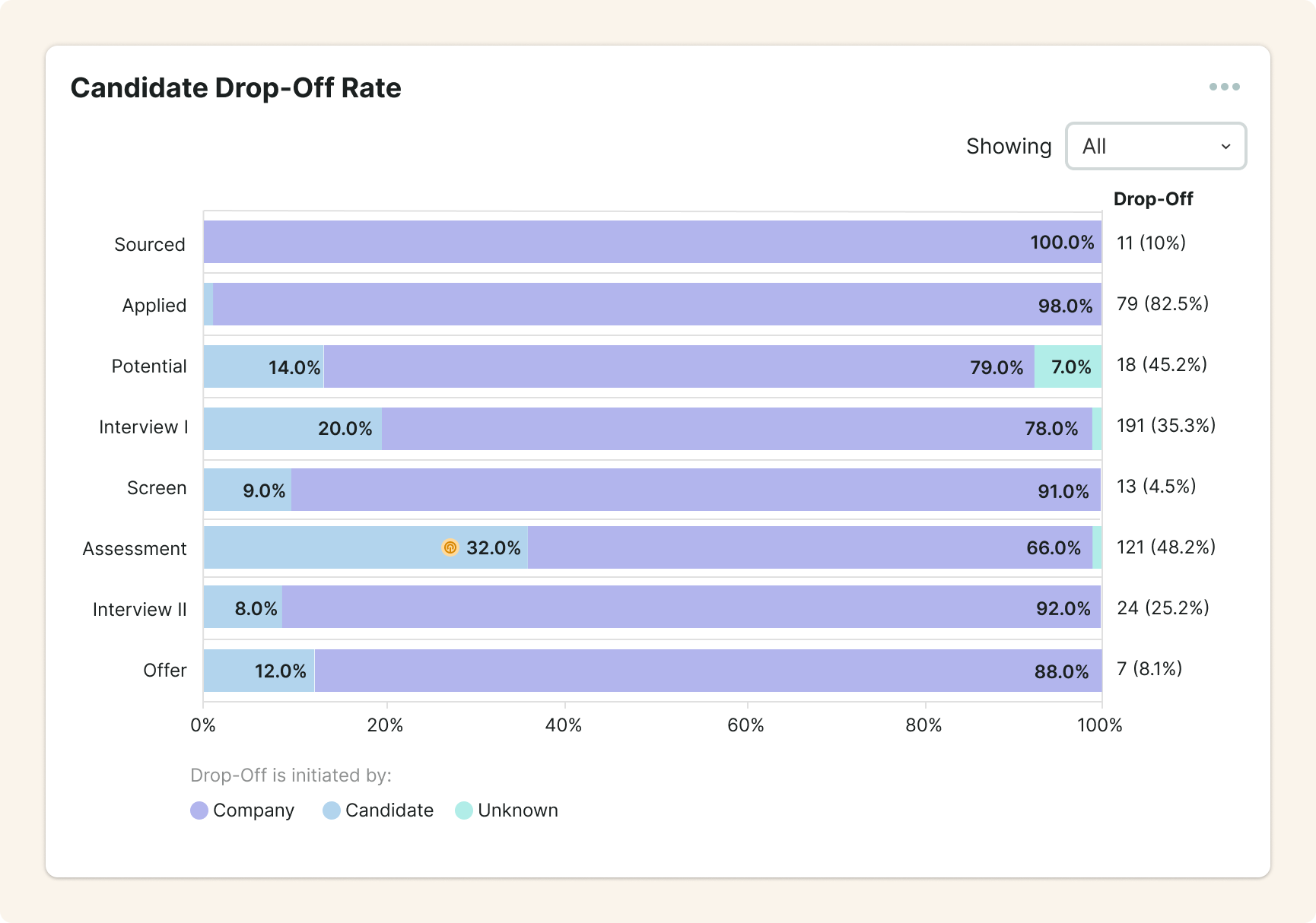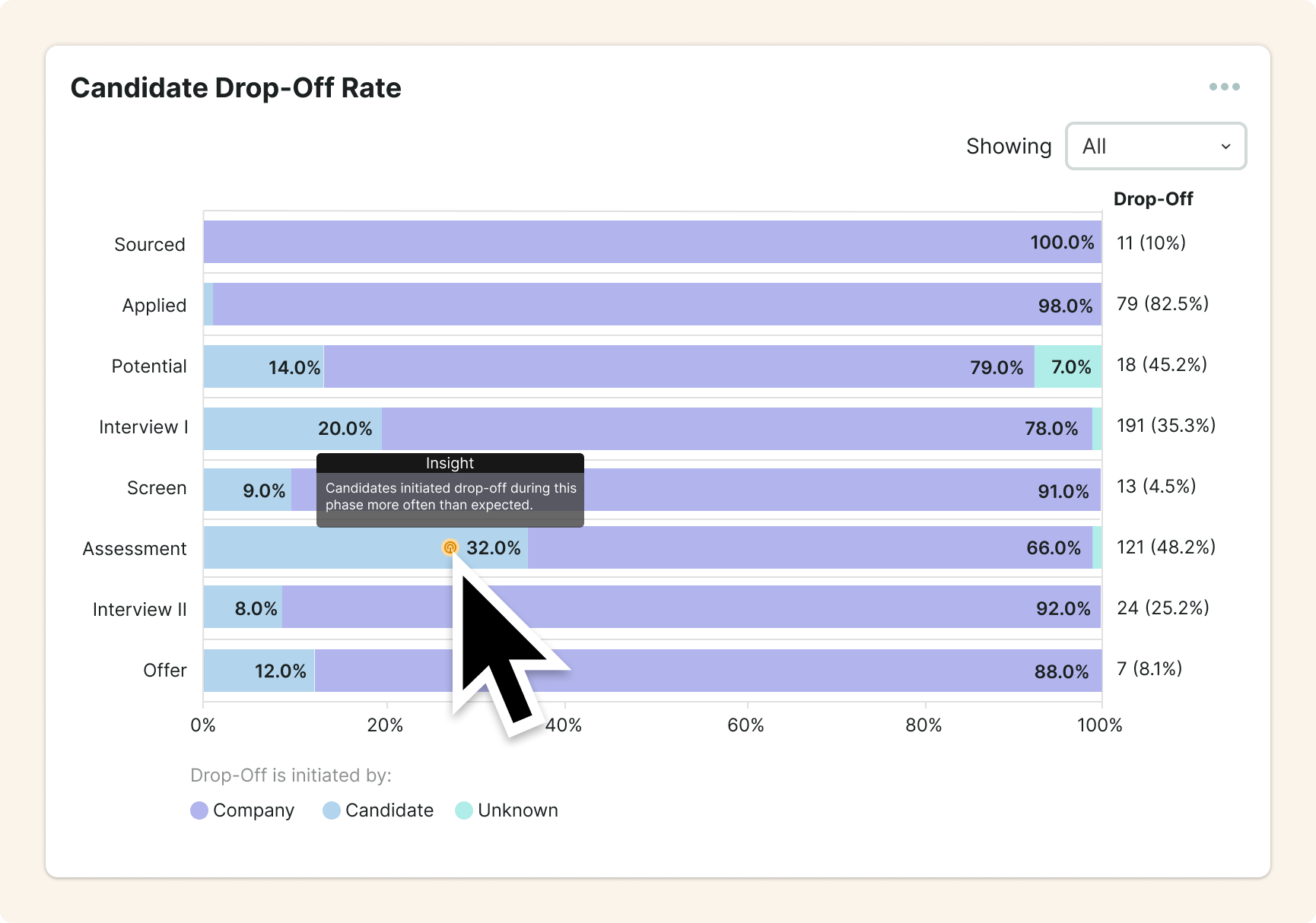Is your recruitment process helping you filter out the best candidates fast? Here’s how measuring the candidate drop-off rate gets you one step closer to it.
A Glassdoor study shows that most companies have a worrying 80% candidate drop-off rate during their application process. Recruitment teams at scaling companies are too often under a lot of pressure to hire faster and hire more. Being able to identify recruitment stages with the highest candidate survival rate allows you to evaluate if your recruitment process is optimal for filtering out the best candidates fast.
Identifying stages with a high number of candidate withdrawals is essential to making the candidate journey even better. So, how can you measure and influence your candidate drop-off rate?
Why is measuring the candidate drop-off rate important?
Evaluating your recruitment process is an important step that can enable you to make useful predictions for future open positions, as well as create a pleasant candidate experience. One of the most relevant aspects of this evaluation is measuring how many candidates drop off during a specific recruitment stage.
In order to get a sense of whether some recruitment stages are too strict or too loose in candidate selection, a clear picture of the drop-off per stage is needed. When supplemented with why the drop-off happened, that information can help you determine which recruitment stages might need reorganization and which might even need to be removed.
Having a clear picture of the number of drop-offs at each recruitment stage can help you fine-tune your whole hiring process. Some recruitment stages might yield too many eligible candidates for further stages, which might create a bottleneck in your hiring.
High drop-off from candidates might also indicate that you are unintentionally losing candidates.
If some stage has a particularly high number of candidate withdrawals, evaluating and reorganizing that stage might be necessary.
Comparing drop-off rates to your predefined expectations on the ideal numbers of each stage will tell you whether you need to rethink how a specific stage is conceptualized. For example, higher drop-off rates in the early stages are to be expected, but higher drop-off rates in later stages that yield too few candidates might indicate an unhealthy drop-off rate.
How to calculate the candidate drop-off rate
Getting information on the drop-off in the hiring journey is by no means a unidimensional calculation.
In order to get a simple notion of what’s happening in your hiring process, you need information on the number of candidates that dropped off during a specific recruitment stage, as well as the number of candidates that successfully passed that stage. That way, you can get both absolute and relative measures on how strict or loose a specific recruitment stage is.
You will be able to get this information by properly managing your candidates in the ATS (Applicant Tracking System).
First, it is important to clearly set the hiring stages in your tool. Having a clearly defined recruitment process will help you identify bottlenecks and optimize your process, but also set clear expectations with your candidates.
Once you’ve defined your recruitment stages, make sure to regularly update the status of your candidates and move them to the appropriate stage. By logging when they moved to the next phase, withdrew their application, or were rejected for a specific reason, you will gather valuable data to analyze.
Not only will you be able to calculate candidate drop off rate per recruitment stage, but you will also have information on whether the drop-off was voluntary or notand what was the reason behind it.
That way, you will be a step closer to getting a complete picture of what your hiring journey looks like. Combine this with the time your candidates spend in each recruitment stage, and you will get a better sense of the bottlenecks in your hiring process.

By registering on the Orgnostic Platform and connecting your ATS, you can get this metric out of the box in a matter of seconds if you have appropriate data!
How to extract deeper insights
The calculations explained so far can provide you with valuable insights when it comes to your so far can be quite sufficient for getting a bigger picture on your recruitment process, but we did not stop there!
Drop-offs initiated by candidates are generally undesirable since they might indicate you are losing good candidates to other companies due to the inefficiency of a specific recruitment stage. In order to unravel stages with particularly high drop-offs initiated by candidates, we are using statistical procedures to surface an insight.

This enables you to pinpoint which stages require deeper evaluation and reorganization just by glancing at the metric!
How to improve the candidate drop-off rate
Improving the recruitment process can unfold gradually and often requires integrating information from different metrics.
The candidate drop-off rate might tell you whether you have some stages that are just too strict or too loose in candidate selection. Those stages might need further evaluation and reorganization. Maybe your assessment tasks are too easy or your HR interview is too demanding? Drop-off reasons might offer some answers to these and other questions.
Furthermore, a large number of candidates withdrawing from your process might indicate a problem with a specific recruitment stage. Are you communicating clearly to set the right expectations with your candidates? Do your recruitment stages last too long?
Establishing clear and timely communication with your candidates during each hiring stage might reduce a candidate’s uncertainty about their position in the hiring pipeline, which will ultimately lead to reduced drop-off rates.
Furthermore, informing your candidates upfront about the whole hiring pipeline, as well as the approximate time you will need for different stages increases the transparency of the process and might lower the drop-off rate.
Last but not least, you can also check the number of applicants per hire, and ask candidates why they are withdrawing from the recruitment process. That way, you’ll get a step closer to fully understanding the hiring journey.
How to automate drop-off rate insights with Orgnostic
To automate getting insights into the drop-off rate for each stage, you can do the following:
- Register on the Orgnostic Platform
- Connect your ATS and your data will automatically be pulled
- Go to Story
- Click on the Talent Acquisition Chapter
- Investigate your “Candidate Drop-Off Rate” metric
You’ll be able not only to compare the drop-off rate between different stages and against your ideal threshold, but also to get insights that nudge you to investigate a specific stage a bit more closely.
To conclude
Keeping track of the candidate drop-off rate is an important step for evaluating and improving your recruitment process.
By comparing the actual drop-off rate to your ideal drop-off rate, you can create a better experience for both the applicant and your whole HR team!